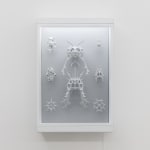Victor Lim Seaward
19 3/4 x 13 3/8 x 4 in.
Further images
This piece draws inspiration from the renowned German zoologist Ernst Haeckel, who dedicated his efforts to mapping and naming a vast array of species. Haeckel's lithographs meticulously documented the extraordinary shapes found in nature. Among these wonders are the radiolaria, which possess elaborate silica skeletons, lending them an otherworldly and almost synthetic appearance. These aquatic organisms have inhabited the world's oceans for half a billion years, representing one of the most ancient life forms—neither animal, plant, nor fungus.
In Seaward’s vitrine, the fineness of structure of the Radiolaria is illuminated by a clinical and unyielding 5000k LEDs, an unremarkable commonplace of our modernity which clashes with the great ancientness of the microorganisms. Their fragility is emphasized by the vitrine they are displayed in, deeming it worth of being preserved and remembered. The artwork presents itself as a relic or a fossil, a piece in a museum, symbolizing a fading or impending cosmology. Playing with the transitoriness of time it reflects on memory and on our understanding of impermanence of existence.
This piece draws inspiration from the renowned German zoologist Ernst Haeckel, who dedicated his efforts to mapping and naming a vast array of species. Haeckel's lithographs meticulously documented the extraordinary shapes found in nature. Among these wonders are the radiolaria, which possess elaborate silica skeletons, lending them an otherworldly and almost synthetic appearance. These aquatic organisms have inhabited the world's oceans for half a billion years, representing one of the most ancient life forms—neither animal, plant, nor fungus.
In Seawards’s vitrine, the fineness of structure of the Radiolaria is illuminated by a clinical and unyielding 5000k LEDs, an unremarkable commonplace of our modernity which clashes with the great ancientness of the microorganisms. Their fragility is emphasized by the vitrine they are displayed in, deeming it worth of being preserved and remembered. The artwork presents itself as a relic or a fossil, a piece in a museum, symbolizing a fading or impending cosmology. Playing with the transitoriness of time it reflects on memory and on our understanding of impermanence of existence.
Exhibitions
Midnight Oil, Brooke Benington, Fitzrovia, London, UK (2023)








